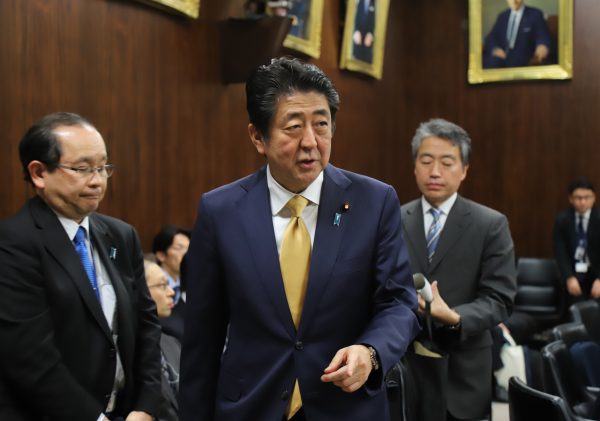The Abenomics reform package on which Prime Minister Abe campaigned was the right one to lift Japan out of two decades of anemic growth. But he hasn’t really committed the political capital needed to take on the vested interests for the reforms that matter most. He continues to do just enough on the economic front to keep the Japanese economy on a stable course but his main political aim is the normalisation of Japan’s military.
The mandate that Abe gave Bank of Japan Governor Haruhiko Kuroda checked Japan’s deflation but it hasn’t lifted prices to the target 2 per cent a year. Much of recorded economic growth has come from crude Keynesianism — fiscal and monetary expansion — instead of structural reforms to lift Japan’s growth potential.
Two big structural challenges still loom over the Japanese economy. The first is the ageing and shrinking population and the other is the unprecedented gross government debt that is running at 240 per cent of GDP.
As Masahiko Takeda explains in this week’s lead essay, ‘Japan’s economic conditions continue to be neither too hot nor too cold’. But nor are they — in Goldilocks’ territory — ‘quite just right’.
The consumption tax will be raised in September, from 8 to 10 per cent, and the Abe government has formally opened up Japan to immigration for the first time. Both measures involve significant compromise. The consumption tax rate will remain at 8 per cent for some food products, introducing a ‘serious distortion’ in consumption, and distorting subsidies will also be introduced. The same food will be taxed differently depending on where it is eaten. It’s administratively messy and poor policy. The more serious risk is the rushing through of the changes to the immigration law. The opening up of Japan to foreign labour that de facto can stay indefinitely has rightly been hailed as a watershed for Japan — a Japan whose total refugee intake in 2017 amounted to only 20 people — but there will need to be much more change if Japanese social cohesion is to withstand the shock.
Foreign labour will be able to enter Japan on a five-year guest worker visa with family, and extend that visa indefinitely. But, as with any successful immigration program, it’s what’s done behind the border that matters most. For foreign-born workers to succeed in Japan, and for Japan to be able to attract the best talent from abroad, immigrants must be accorded equal rights, equal access to services and the chance to succeed in society.
The risk is that a new foreign-born population in Japan, eventually with Japanese born children, will be marginalised and discriminated against in society. It is widely recognised that third generation Koreans, or Zainichi, do not get equal treatment in Japan today.
Immigration reform done right would require more preparation for Japanese businesses and the community to accept an influx of foreign talent. Japan is prosperous, safe and an attractive destination for migrants but can’t expect to attract the best automatically without providing language and other support for assimilation and the chance of success in Japanese society.
The change in Japanese migration policy is most welcome but its opportunistic and slapdash implementation could cruel otherwise good reform.
Externally, Takeda reminds us that the US–China trade tensions could also cause strong headwinds for the Japanese economy. The US approach to dealing with trade problems with China is holding the WTO trade regime hostage to having its way with China and threatens Japanese prosperity and global trade.
It may appear that Japan is helpless in the external challenge of a US–China trade war but Japan is president of the G20 at this key moment. The G20 communique in Argentina late last year opened up the opportunity of reforming the WTO.
Japan has assets to deploy in finding ways to resolve the China–US tensions in a multilateral setting. In a region where leaders are coming and going or challenging the global status quo, Abe and Japan have provided stable leadership that led to the conclusion of the TPP without the United States, and has seen a breakthrough in improving the difficult China–Japan relationship.
Abe’s never been shy about his long-cherished aim of revising the Article 9 peace clause of the Japanese Constitution to allow for a more normal military. But his legacy will be more likely determined by how Japan manages its new immigration program and its G20 presidency.
Muddling through on immigration reform and the G20 presidency in full view of the world will hardly be enough.
The EAF Editorial Board is located in the Crawford School of Public Policy, College of Asia and the Pacific, The Australian National University.

